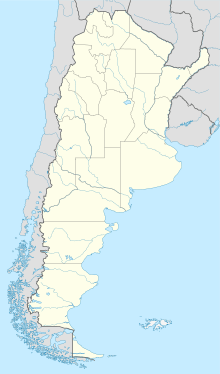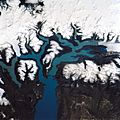Los Glaciares National Park facts for kids
Quick facts for kids Los Glaciares National Park |
|
|---|---|
| Location | Santa Cruz Province, Argentina |
| Nearest city | El Calafate |
| Area | 726,927 ha (2,806.68 sq mi) |
| Established | May 11, 1937 |
| Governing body | Administración de Parques Nacionales |
| UNESCO World Heritage Site | |
| Criteria | Natural: vii, viii |
| Inscription | 1981 (5th Session) |
Los Glaciares National Park (which means "The Glaciers National Park" in Spanish) is a huge protected area in Argentina. It's located in Santa Cruz Province, in the southern part of the country.
This park is Argentina's largest national park. It covers over 7,200 square kilometers (about 2,800 square miles)! That's bigger than some small countries. The park was created on May 11, 1937. It protects amazing forests and wide-open plains, full of different plants and animals. In 1981, UNESCO named it a World Heritage Site. This means it's super important for everyone to protect.
The park gets its name from the giant ice cap in the Andes mountains. This ice cap is one of the biggest in the world, outside of Antarctica and Greenland. It feeds 47 large glaciers! Thirteen of these glaciers flow towards the Pacific Ocean. In most places, glaciers start very high up, but here, they begin at only about 1,500 meters (4,900 feet). They then slide down to just 200 meters (650 feet) above sea level. Los Glaciares National Park shares a border with Torres del Paine National Park in Chile.
Contents
Exploring the Park's Geography
About 30% of Los Glaciares National Park is covered by ice. The park can be split into two main parts. Each part has a very large lake. In the south, you'll find Lake Argentino, which is Argentina's biggest lake. It covers about 1,466 square kilometers (566 square miles). In the north, there's Lake Viedma, covering about 1,100 square kilometers (420 square miles). Both of these lakes feed the Santa Cruz River. This river flows all the way to the Atlantic Ocean. Between the two lakes is an area called Zona Centro, which is not usually visited by tourists.
Northern Part: Mountains and Glaciers
The northern part of the park includes a section of Lake Viedma. It also features the Viedma Glacier and some smaller glaciers. This area is very popular for climbing and trekking. Famous mountains like Mount Fitz Roy and Cerro Torre are found here.
Southern Part: Famous Glaciers
The southern part of the park is home to some of the most famous glaciers. These include the Perito Moreno Glacier, Upsala Glacier, and Spegazzini Glacier. These huge ice rivers flow into Lake Argentino. You can take boat trips to see the Upsala and Spegazzini glaciers. These trips often pass by huge icebergs. The Perito Moreno Glacier is special because you can reach it by land.
Park Weather: Cool and Moist
The park has a cool and moist climate. This means it's often chilly and a bit wet. In winter, the average temperature is around 0.6 degrees Celsius (33 degrees Fahrenheit). In summer, it's about 13.4 degrees Celsius (56 degrees Fahrenheit). However, if you go higher up in the mountains, it can be much colder, even below freezing all year.
The park gets a good amount of rain and snow. The western part gets about 500 mm (20 inches) of rain each year. The eastern part gets more, around 900 mm (35 inches). This rain and snow falls pretty evenly throughout the year. Snowfall is common during the colder months.
Amazing Wildlife and Plants
The tall mountains block most of the moisture coming from the Pacific Ocean. This creates a dry, cold area on the Argentine side of the mountains, known as the Patagonian steppe.
Animals of the Steppe
This dry steppe is home to many animals. You might see rheas, which are large, flightless birds. Guanacos, a type of llama, also live here. Predators like cougars and South American gray foxes roam the land. Sadly, the gray fox is endangered because of human activities. While guanacos are not endangered, their numbers have dropped a lot due to livestock grazing. The park is also a birdwatcher's paradise, with over 100 species. You might spot huge condors and various eagles flying overhead.
Forests and Their Inhabitants
Between the icy areas and the dry steppe, there's a fertile zone of Magellanic subpolar forests. These forests are mainly made up of lengas and guindos trees. You can also find ñires trees here. In these greener, more welcoming areas, you might spot huemul deer. These deer are also endangered. You might also see the unique torrent duck, which lives in fast-flowing rivers.
Challenges the Park Faces
Los Glaciares National Park faces several challenges. These include issues from tourism, overgrazing by animals, and forest fires. Some parts of the park have problems with too many animals grazing. There are also invasive animals like cattle, European hares, and certain types of trout. Forest fires have caused a lot of damage to the park, destroying parts of its natural beauty.
Visiting Los Glaciares National Park
Los Glaciares is a very popular place for tourists from all over the world. Many tours start from the village of El Calafate. This village is on the shore of Lake Argentino, just outside the park. The park's main office is also located here. Another starting point is El Chaltén village, in the northern part of the park. It's located at the base of Mount Fitz Roy. Other interesting places to visit in the park include Lago del Desierto and Lago Roca.
The park was also used as a filming location for "Return of the Ice." This was an episode of the science documentary series The Future is Wild.
Images for kids
-
Iceberg at Lake Argentino's northern arm
-
Iceberg floating in the Argentino Lake near the Upsala Glacier
-
The Viedma Glacier flowing into Lake Viedma (NASA)
See also
 In Spanish: Parque nacional Los Glaciares para niños
In Spanish: Parque nacional Los Glaciares para niños









